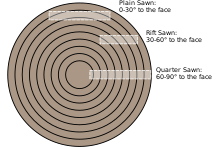Rift sawing
Rift-sawing may be done strictly along a log's radials—perpendicular to the annular growth ring orientation or wood grain—or as part of the quarter sawing process.
This produces stable boards with comparatively thin grain; least susceptible to warping, twisting, or cupping; and hence most valued for products where dimensional stability is critical (e.g. musical instruments, high-end sports equipment).
The Architectural Woodwork Institute (AWI) refers to such cuts as having "radial" or "edge grain", but does not describe them as "rift sawn".
[4] Compared to other sawing methods, radially cut rift-sawn lumber is more difficult to produce, and results in much more waste in the form of wedges.
The angle of the bastard grain may differ along the width of the board or between opposing sides, and enhances the appearance of ray fleck.
